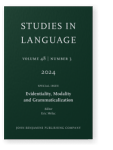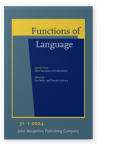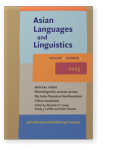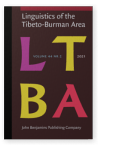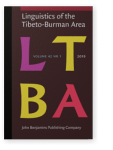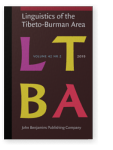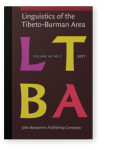Hiroyuki Suzuki
List of John Benjamins publications for which Hiroyuki Suzuki plays a role.
2024 The paradigmaticity of evidentials in the Tibetic languages of Khams Evidentiality, Modality and Grammaticalization, Mélac, Eric (ed.), pp. 723–752 | Article
This article argues that the evidential system of Khams Tibetan, a cluster of Tibetic languages spoken in the south-eastern Tibetosphere, should be considered a verb paradigm. We propose a paradigm with six evidential categories (egophoric, statemental, visual sensory, nonvisual sensory, sensory… read more
2024 Functional transition from hear to nonvisual sensory and hearsay evidential categories: A case study of rGyalthang Tibetan The Functions of Evidentiality, Mélac, Eric and Pascale Leclercq (eds.), pp. 63–89 | Article
This article presents a development of evidential categories derived from a verb related to the auditory sense in the evidential system attested in rGyalthang Tibetan varieties. The language varieties under study possess a morphological distinction of at least five evidentials in the… read more
2023 Geolinguistic approach to migration history in the south-eastern edge of the Tibetosphere: A case study of Sangdam Tibetan and methodological remarks Ethnolinguistic contact across the Indo-Myanmar-Southwestern China mountains, Coupe, Alexander R., Randy J. LaPolla and Hideo Sawada (eds.), pp. 224–250 | Article
This article examines the migration history of Tibetic language-speaking people in the south-eastern corner of the Tibetosphere, particularly the origin of Sangdam Tibetan, spoken in Kachin State, Myanmar, by adopting a geolinguistic approach with linguistic maps. It first presents the current… read more
2022 Evidentiality in Selibu: A contact-induced emergence Diachronica 39:2, pp. 268–309 | Article
Selibu is a Mandarin-Khams Tibetan mixed language with about 900 native speakers in northwest Yunnan, People’s Republic of China. As a Form-Semantics mixed language, it derives most of its lexicon and grammatical morphemes from Southwest Mandarin and borrows its morphosyntactic and semantic… read more
2021 /ka-/ negative prefix of Choswateng Tibetan of Khams (Shangri-La, Yunnan) Language and Linguistics 22:4, pp. 593–629 | Article
Choswateng Tibetan, spoken in the south-eastern corner of the Khams region, has three negative prefixes: /ȵi-/, /ma-/, and /ka-/. The first two are derived from two morphemes which are ubiquitous across Tibetic languages, whereas the third is a newly generated negative prefix found in Choswateng… read more
2021 Hearsay evidential marking strategy in Lhagang Tibetan: A case study on folktales and legends Linguistics of the Tibeto-Burman Area 44:2, pp. 157–182 | Article
This exploratory study focuses on the use of hearsay evidential marking in the course of storytelling in a Tibetic language, Lhagang Tibetan, combining a descriptive linguistic approach with a literary-theoretic analysis. Tibetic languages generally possess a morpho-syntactically encoded… read more
2019 Newly recognised languages in Chamdo: Geography, culture, history, and language Linguistics of the Tibeto-Burman Area 42:1, pp. 38–81 | Article
This article presents information regarding newly recognised non-Tibetic Tibeto-Burman languages spoken in three counties, Dzogang, Markham, and Drag-yab, of Chamdo Municipality and the adjacent Dzayul County in the Tibet Autonomous Region. First, we introduce four languages – Lamo, Larong sMar,… read more
2019 Humilifics in Mabzhi pastoralist speech of Amdo Tibetan Linguistics of the Tibeto-Burman Area 42:2, pp. 222–259 | Article
Politeness strategies using specific word forms and morphemes are well known in Tibetan, in which honorific expressions are in the majority. However, for Amdo Tibetan the politeness register is less well known. In this paper, the humilific politeness system of Mabzhi Amdo Tibetan is discussed in… read more
2017 Phonetic distance and dialect clustering on the Qinghai-Tibet plateau Linguistics of the Tibeto-Burman Area 40:2, pp. 161–178 | Article
The goal of this paper is to use string edit distance to describe the synchronic relationship between the Tibetan speech varieties located on the Northeastern edge of the Tibetan Plateau. String edit distance provides a statistical way to compare a large number of linguistic features, in essence… read more
2015 Discovering endangered Tibetic varieties in the easternmost Tibetosphere: A case study on Dartsendo Tibetan Linguistics of the Tibeto-Burman Area 38:2, pp. 256–270 | Article
Dartsendo (Dar-rtse-mdo in Written Tibetan), generally known as Kangding, is a town in the easternmost Tibetosphere, located in Ganzi (dKar-mdzes) Prefecture, Sichuan, China. This town has played an important role for the tea-horse trade since the Ming Dynasty, and is inhabited by both Tibetan and… read more
